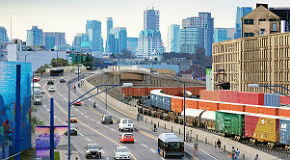What we are doing
We are replacing the Powell Street rail line level crossing near Raymur Street with a multi-use overpass. This new overpass will have four lanes of vehicle traffic, two pedestrian sidewalks, and a counter-flow bike lane.
We are also realigning a portion of Powell Street to the south so a new east-west rail track can be added. This track will increase capacity and improve access to and from the port.
Finally, we are creating dedicated cycling lanes and sidewalks to improve safety and connectivity to the planned Portside Greenway, which will run from downtown to Boundary Road as part of the City’s Greenways Network.
Why we started this project
We are creating the Powell Street overpass to:
- Improve walking and cycling in the area
- Improve transit and vehicle movement in the area
- Improve rail operations for the port
Improving walking and cycling
We will provide safe, convenient, and comfortable walking and cycling routes for people of all ages and abilities. We will do this by:
- Separating pedestrians and cyclists from vehicles
- Providing better east-west connections for cycling and walking within the neighbourhood
- Creating a core section of the planned Portside Greenway that will run from downtown to Boundary Road as part of the City’s Greenways Network
Improving transit and vehicle movement
We will improve transit and vehicle movement and safety in the Powell Street corridor. We will do this by:
-
Reducing congestion and delays at the road/rail level crossing for pedestrians, cyclists, vehicles and six transit bus routes (No. 4, 7, 209, 210, 211, 214)
Improving rail operations
We will improve rail operations to and from the port. We will do this by:
- Expanding capacity and improve efficiency of the rail network to support trade and goods movement through Port Metro Vancouver.
- Providing space for a new east-west CP Rail track south of the existing tracks
- Eliminating the Powell Street-Burrard Inlet Rail Line road/rail level crossing
- Allowing for improved rail connection between the port and the False Creek rail yards, and south to the USA via the Burrard Inlet rail line
See the Economic Development Strategy for details of the City of Vancouver’s support for port, rail and trade gateway infrastructure.
City policies that guide this project
Supporting our port as a trade gateway
As part of the City's economic development strategy, we are committed to supporting our port as a trade gateway. We do this by protecting industrial and rail lands from development, so that the Port continues to thrive.
We are improving access to the Port for goods movement by rail and truck while addressing local community needs and impacts.
Reducing the city's carbon footprint
In order to reach our goal of becoming the greenest city in the world by 2020, it is important that we support the movement of goods by rail as much as possible.
City policy favours goods movement by rail over trucking, due to rail’s lower environmental impacts and reduced overall community impacts.
Improving the safety and efficiency for cycling, walking, and public transit
We prioritize cycling, walking, and public transit as preferred modes of transportation, and are also committed to improving the safety and efficiency of pedestrian, cycling, transit, and vehicle movement both city-wide, and in the Powell Street corridor.
This project will contribute to these goals by providing dedicated cycling lanes and improved sidewalks. It will also remove the Burrard Inlet Rail Line road/rail level crossing for cyclists, pedestrians and buses, which will improve safety for all road users and reducing traffic delays.
Who we are working with
The City of Vancouver will contribute $3.75 million and is responsible for delivering the project on behalf of funding partners. Other partners include:
- Port Metro Vancouver ($19.5M)
- Transport Canada ($18.5M)
- CP Rail ($4.5M)
- TransLink ($3.75M).
Involving residents, businesses, and community groups
We began consulting and collecting feedback about the project from businesses, residents, and community groups in the spring of 2012.
We held a public open house on May 24, 2012 and stakeholders were also offered the opportunity to provide feedback in writing or by email, or to schedule an in-person meeting with City staff.
Feedback we have received from the public
Feedback we have received includes:
- Concerns about the impact of the extended closure of Powell St during overpass construction on local businesses and residents (access and traffic management).
- Support for the improved pedestrian and cycling connections along Powell St.
- Interest in minimizing graffiti and vandalism on of the overpass.
- Employment opportunities for local residents from the Downtown Eastside during project construction.
Staff continue to work with partner organizations to finalize project details, and will consider additional public input as the project moves forward.
Managing traffic in the area
City staff will monitor our traffic plan to make sure local streets and communities are not affected. We will make changes to the plan to address any issues, if required.
The City is also working closely with Translink and Coast Mountain Bus Company to maintain transit service levels in the area.
February 2013
Localized site preparation is expected to have minimal traffic impacts with limited and temporary lane closures scheduled during off-peak hours.
June 2013 to summer 2014
Powell Street will be closed to traffic between Hawks Avenue and Clark Drive. Access will be limited to business and local traffic only.
- Businesses in the area will remain open
- The intersections at Hastings/Clark and Hawks/Hastings will be modified to facilitate the detour
- Commuter traffic not destined for local business along Powell St and Cordova St should use alternate arterial routes
 Powell Street Overpass project
Powell Street Overpass project


